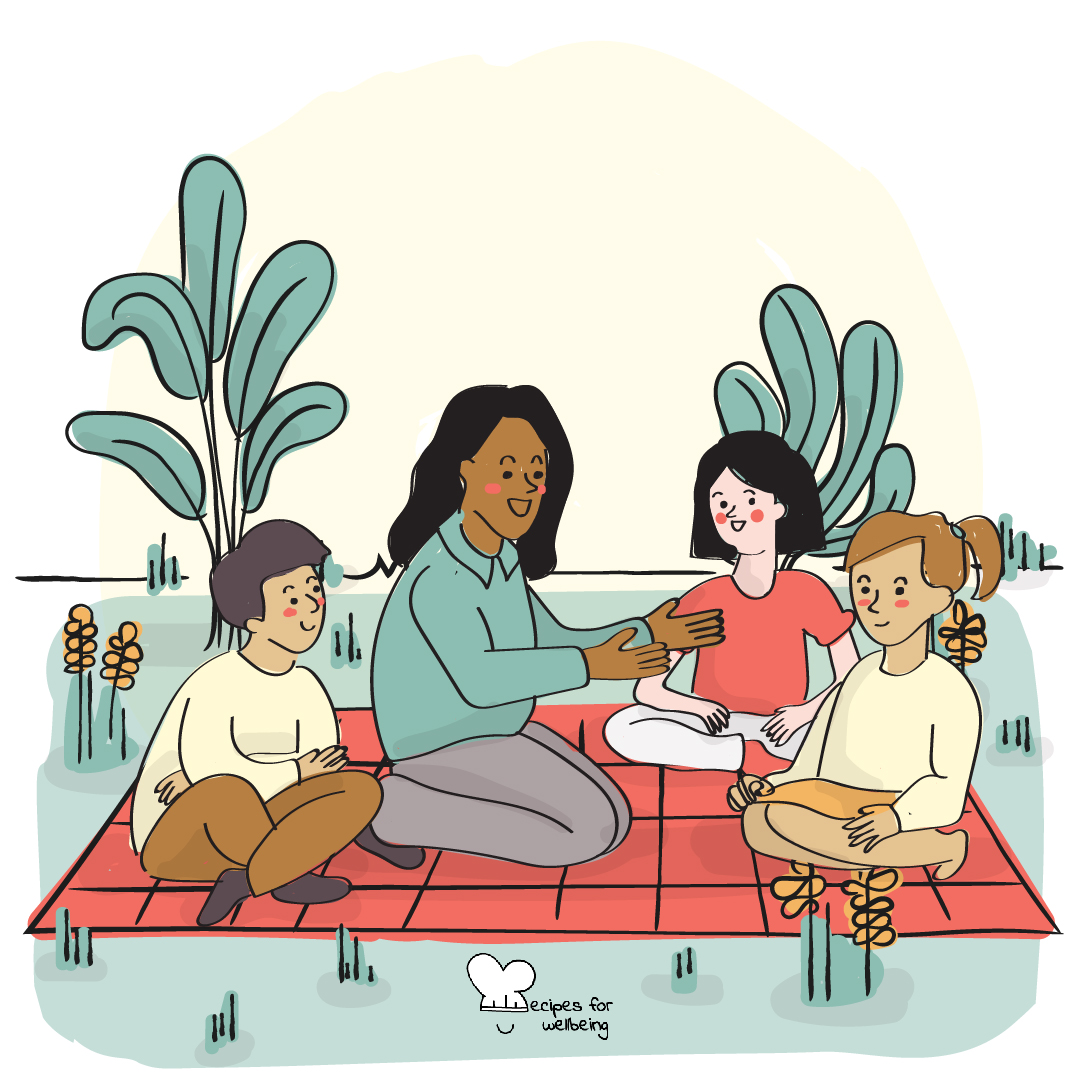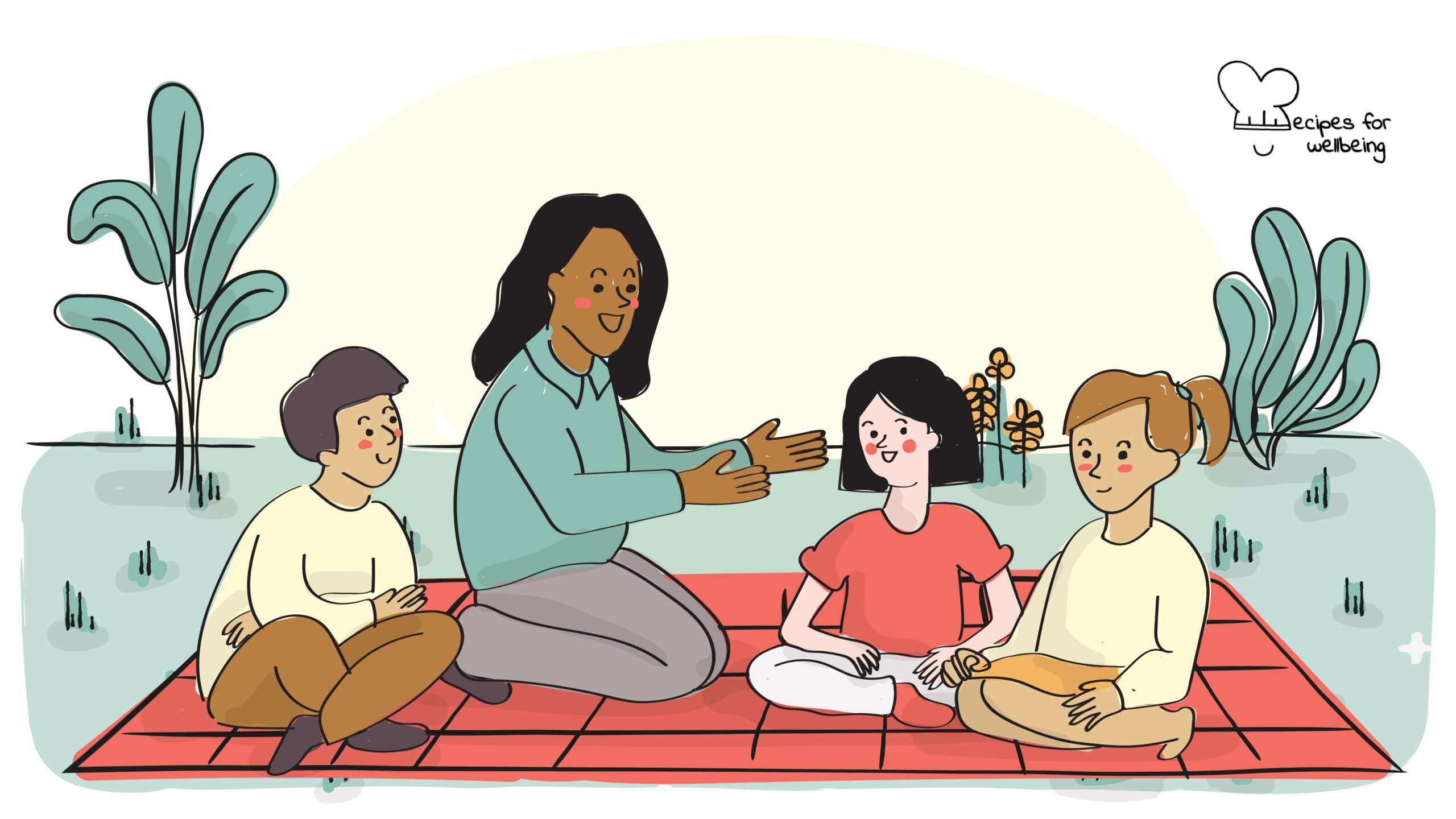
Koeppen’s relaxation for children
Everything you can imagine is real. ―Pablo Picasso
 Serves: 11-25 people, 2-10 people, 26-40 people
Serves: 11-25 people, 2-10 people, 26-40 people
 Difficulty: Easy
Difficulty: Easy
 Total time: 11-30 minutes
Total time: 11-30 minutes
 Ingredients: A quiet place with no distractions, open mind to relax, at least 1 adult to guide the exercise and 1 child (suitable for children between 5 and 11 years old), quiet background music (if desired)
Ingredients: A quiet place with no distractions, open mind to relax, at least 1 adult to guide the exercise and 1 child (suitable for children between 5 and 11 years old), quiet background music (if desired)
 Wholebeing Domains: Awareness, Discomfortability, Rest
Wholebeing Domains: Awareness, Discomfortability, Rest
 Wholebeing Skills: Agency, Centring, Focus, Mind-body-connection, Non-attachment, Relaxation, Relief, Seeking support, Self-regulation, Stress management
Wholebeing Skills: Agency, Centring, Focus, Mind-body-connection, Non-attachment, Relaxation, Relief, Seeking support, Self-regulation, Stress management

Koeppen’s relaxation for children
 Description
Description
A technique for working on anxiety for the little ones.
Anxiety and stress are not problems only adults experience, but are common experiences for children too. However, children sometimes struggle to identify anxiety since they express their emotions in a different way compared to adults. Also, children often do not have the tools to alleviate and release the symptoms. This is why it is important to teach them strategies to help them recognise these emotions and deal with them appropriately.
The following recipe is inspired by Koeppen’s relaxation method, which consists of being aware of each muscle group and alternating tension and relaxation of the muscles. This activity can be done jointly by parents and children and it helps reduce anxiety levels in children, as well as improve their sleep, concentration, memory, and self-confidence. This recipe has kindly been adapted by Alejandra Duque, Felipe Gutiérrez, and María Ángeles de la Cruz of the UNO+OTRO team, an initiative by Needlab to promote mental healthcare, especially during the COVID-19 pandemic.
 Steps
Steps
Step 1 – Squeeze lemons (1’)
Imagine you are in a kitchen and want to drink some lemon juice. To do this, you must squeeze a lemon. Take the lemon with your right hand and squeeze it strongly – watch how the juice comes out. Then stop squeezing it, open your hand and let it rest a bit.
Step 2 – Look at your hand (1’)
Notice the difference in your sensations when you squeeze the lemon versus when you stop squeezing it. When you squeeze the lemon for a long time, your hand gets tired and you feel like there are pins and needles. When you release the lemon, you might feel a warm and tickling sensation, meaning your hand is recovering.
Step 3 – Finish making your lemon juice (6’)
Squeeze two more lemons with your right hand and 3 lemons with your left hand. Each time, try to squeeze it harder than the previous one, so that your juice is very delicious. Whenever you let go of that imaginary lemon, try to do so more and more slowly.
Step 4 – Kitten arms (1’)
Now imagine that you are a very lazy kitten. You are in your bed sleeping and suddenly you wake up.
Step 5 – Release the laziness (1’)
Since you just woke up, you have to release all the laziness in your body. To do this, stretch your arms and hands behind your head, as high as you can.
Step 6 – Let go of your hands (1’)
When you feel a tickling sensation after stretching so much, let your arms fall by the sides of your body, as if you were a rag doll.
Step 7 – Repeat (3’)
Repeat steps 5 and 6 twice more, so that the kitten is more awake to play during the day.
Step 8 – Turtle (1’)
Now imagine you have become a turtle that is lying in the sun. You hear a sudden noise that scares you and you retreat your head to your shell, lifting the shoulders towards your ears so you are well hidden.
Step 9 – Observe (2’)
When you feel that the danger has passed, pull your head out of that shell, lowering the shoulders very carefully. Watch out! The strange noise is back again – so hide! Hide your head until everything passes. The sound seems to have gone away, finally. Pull your head out again very slowly. This time you know you’re safe.
Step 10 – Countryside (1’)
Now you have transformed yourself into a field in the countryside. It’s a beautiful sunny day. Feel the smell of the trees and the fresh air.
Step 11 – Listen (1’)
Oh, oh! You hear another noise – it’s an elephant herd! You don’t have the time to run, but you have an idea! You lie down in the meadow and make your belly as hard as you can, so that the elephants’ legs cannot hurt you.
Step 12 – Wait (1’)
Watch the elephants go, relax your belly and breathe. What a relief! How ingenious you are!
Step 13 – Let three more elephants pass (3’)
You realise that three more elephants are coming; harden your belly again with all the strength you have and relax after each elephant has passed. Now you are safe.
Step 14 – Desert (1’)
After this epic adventure in the countryside, you teleport to the desert. You find an oasis and you can even spot camels relaxing by the palm trees. You decide to explore a little.
Step 15 – Quicksand! (1’)
As you walk around, you find yourself trapped in quicksand and before you realise it, you start to sink. To free yourself, squeeze your feet with all the strength you have – squeeze them very tight!
Step 16 – Coming out (2’)
You are freeing yourself from the quicksand, slowly coming to the surface. Relax your feet for a moment. Feel a gentle tickle. Oh no, you’re sinking again! Squeeze your feet as hard as you can, until you are fully free from the quicksand. You feel calm and proud of having gotten out of such a dangerous situation!
Step 17 – Lake (2’)
At the end of the desert you spot a lake with crystal-clear water. Go for a swim and say out loud something nice or that you like to be reminded of.
Step 18 – Signal (1’)
Ask children to slowly make the “okay” sign and squeeze (or any other small behaviour that is not too noticeable and that they don’t normally do like pinching their ear lobe) to signal they are relaxed. Then, remind them that when they begin to feel uncomfortable, they can squeeze again (or pinch their ear lobe) to reach the feelings of relaxation once again.


 Arabic
Arabic Chinese (Simplified)
Chinese (Simplified) Dutch
Dutch English
English French
French German
German Italian
Italian Portuguese
Portuguese Russian
Russian Spanish
Spanish